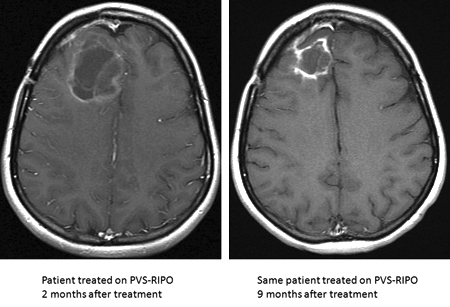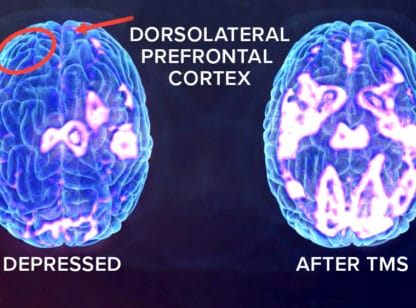Since 2012, medical researchers at Duke University’s Preston Robert Tisch Brain Tumor Center have been studying the utility of what was formerly a major threat to the public as the new treatment modality for one of today’s scariest killers.
Glioblastoma multiforme is the most common primary brain tumor. Radiation and genetic predisposition are thought to be the major risk factors for developing this deadly tumor that attacks innocent, unsuspecting people every day. What can simply start with a headache, nausea/vomiting, and seizures can be the warning signs of this roughly one-year death sentence.

MRI of a patient’s brain, axial view, at 2 months and 9 months after PVS-RIPO treatment (Source: Duke Preston Robert Tisch Brain Tumor
Center website)
Here’s the good news.
Due to the outstanding work of Duke researchers, the Food and Drug Administration (FDA) has declared “breakthrough status” for the recent results following phase 1 clinical trials with poliovirus. Although today’s youth may not understand the significance of the poliovirus due to suppression with vaccines, it was a historically significant infectious virus with a wide range of symptoms and could result in paralysis/paresis as in the case of President Franklin D. Roosevelt. Presently, this virus is being harnessed to help fight brain tumors, and the results are impressive! The Duke Chronicle cites that the study found a 20% three-year survival rate in patients with glioblastoma who received the poliovirus therapy, compared to a 4% survival rate.
On a recent 60 Minutes television broadcast Dr. Matthius Gromeier, who developed the activated the polio vaccine called PVS-RIPO, explained that it works by signaling the immune system to destroy the tumor. MRI tests from the clinical trials show remarkable shrinking of the tumor. These images can be viewed on the CBS News website for 60 Minutes entitled Killing Cancer.
Where will the research on this topic go from here?
The status granted by the FDA means that researchers will work extensively with the FDA to develop continued clinical trials. However, we must keep in mind the difference between “treatment” and “cure.” Additionally, publicizing these developments should not make readers believe that there will be a swift movement in the medical community to adopt this method as a gold standard for treatment. Nonetheless, brilliant advancements like this one will
save lives.
Dr. Fiani is a neurosurgery resident with Desert Regional Medical Center’s Graduate Medical Education Program.













































Comments (0)